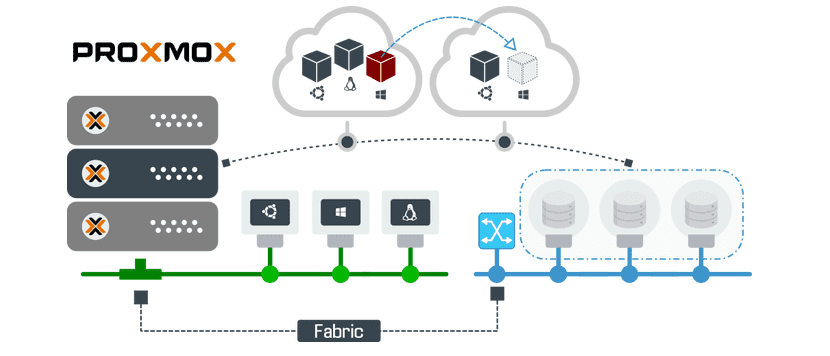
Some days ago Proxmox Server Solutions GmbH, developer of the free virtualization platform Proxmox Virtual Environment (VE), released version 6.0. The Proxmox VE 6.0 platform It is based on Debian 10.0 Buster and Linux Kernel 5.0.15 (based on Ubuntu 19.04 Disco Dingo). The developers have updated QEMU 4.0.0, LXC 3.1.0, ZFS 0.8.1, Nautilus Ceph 14.2.1, and Corosync 3.0.2.
For those who are unaware of Proxmox, they should know that this is a free virtualization management platform (AGPLv3) to manage KVM virtual machines and LXC containers
.
Proxmox VE includes a Web console and command line tools, and provides a REST API for third-party tools. Two types of virtualization are supported: LXC-based containers (as of version 4.0 it replaces OpenVZ, used in version 3.4, inclusive), and virtualization with KVM.
Main features in version 6.0
In this new version of Promox VE 6.0 Ceph Nautilus goes to version 14.2.1 and the panel has been improved by Ceph. Proxmox VE allows an administrator to very quickly and very quickly configure a cluster of Proxmox VE servers with Ceph in hyperconvergence.
Version 6 includes Ceph 14.2.1 and brings many new management features to the web interface- an overview of the cluster displayed in the "Data Center" view; a new "donut" chart illustrating the activity and status of the placement groups (PG).
Corosync 3 and Kronosnet
With Proxmox VE 6.0, communication between server cluster nodes now uses Corosync 3 and Kronosnet, which has changed the format on the cable. Corosync uses unicast as the default transport medium.
This facilitates fault control because priorities can be assigned to different networks. In the web interface, a new selection widget is available for the network, which makes it easy to select the correct link address and thus avoid typos.
ZFS 0.8.1, with native encryption and TRIM for SSD
This new version of ZFS in Proxmox VE 6.0 provides native ZFS file system encryption, which improves security.
Encryption is built directly into the zfsy utility, thus allowing convenient key management.
Proxmox VE 6.0 also supports trim. With the zpool trim command, the operating system informs the SSD of the availability of unused blocks. TRIM helps improve resource utilization and increase the longevity of SSD storage. Additionally, support for checkpoints has been added at the ZFS group level.
In addition, ZFS now supports UEFI and NVMe. Proxmox VE manages the ZFS root through UEFI. For example, a ZFS mirror can be started on SSD storage devices in NVMe format. By using systemd-boot as a boot manager instead of GRUB, all functions at the group level can be enabled in the root group.
QEMU 4.0.0
Users can use the web interface to migrate active hosts to local storage. It is also possible to modify the number of virtual processors of the virtual machines. Too support for Hyper-V illuminations has been added, which improves Windows performance on a virtual machine running QEMU / KVM.
Of the other changes that stand out in this new version of Proxmox VE 6.0, are the following:
- Viewing guest status in web interface tree view, other guest statuses (migration, backup, snapshot, locked) are displayed directly in tree view
- Better hardware detection during installation - Hardware detection has been revised by the installer and now several new devices are detected;
- The authentication key is automatically changed every 24 hours - the key life is limited to 24 hours to reduce the impact of a lost key or an intentional violation of security rules by the user.
Download and support
Proxmox VE 6.0 is now available for download on its website official. The link is this.